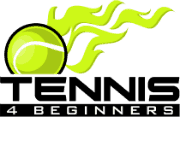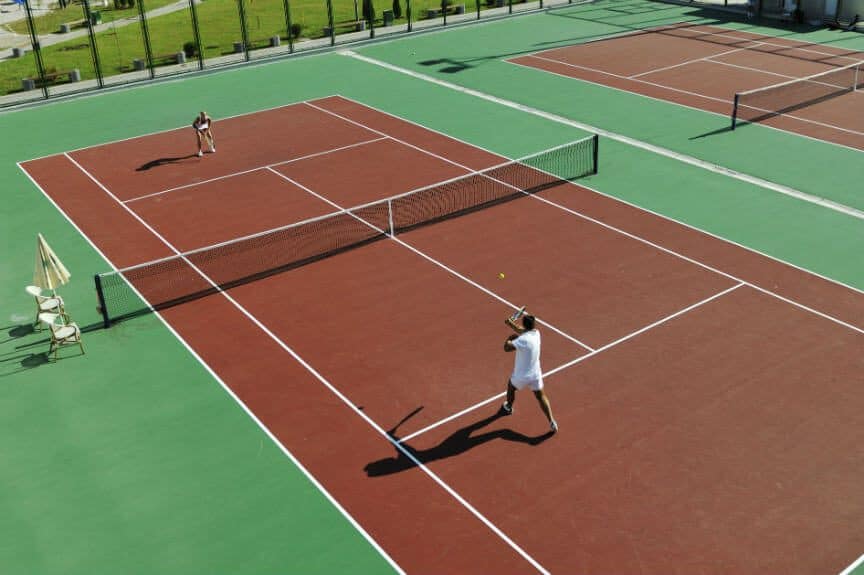Tennis rules have changed little since the origin of lawn tennis in England in the late 1890s. Two exceptions are the elimination in 1962 of the service rule requiring at least one foot to be planted at all times, and the tiebreaker, which wasn’t introduced until the 1970s.
Modern tennis is a racket sport played on a 78 feet (23.77 m) x 36 ft (11 m) level rectangular court surface divided by a 3′-0″ (0.91 m) high net in the middle. Players on opposite ends of the court attempt to clear the net while keeping the ball in play until hitting a winner or until one player makes a mistake. This may include hitting a shot into the net, out of the tennis court boundaries, or allowing the ball to bounce more than once.
Tennis courts are typically built from clay, natural grass, or a hard surface such as concrete, asphalt, acrylic, or other synthetic surfaces. The full width of the court is used in doubles matches, while the singles matches are confined to the singles sidelines.
Shots Used in Tennis
The game of tennis is played using various types of shots. The service, or serve for short, is an overhead shot taken at the start of a point. This is followed by the return, the ensuing shot taken by the receiving player.
The next sequence of shots might include a groundstroke if played from the baseline after the ball bounces, or a volley if played up at the net without allowing the ball to bounce. Whereas groundstrokes involve a full swing and follow-through, a volley is played using a shortened swing and little to no backswing.
A half volley is similar to a volley, except that it is hit just seconds after the ball bounces. Typically half volleys are played a bit further back from the net than volleys, and low to the ground. They are generally executed just in front of a player’s feet.
Groundstrokes can be played either as a forehand shot, taken from the player’s dominant side in a forward swinging motion, or a backhand shot, taken from the opposite side in reverse motion. Traditional forehand shots are performed with the palm of the hand leading the racket.
Backhands can be executed as either a one-handed backhand or a two-handed backhand. Forehands are most commonly played as a one-handed stroke, though it is possible to hit the forehand as a two-handed stroke.
Additional Shots and Spin
Some additional shots used in the game include the lob, a shot placed over the opponent’s head when they are up at the net, the drop shot which is a lightly hit shot that just makes it over the net, and the smash which is an overhead shot taken with or without a ball bounce.
An approach shot is a shot placed by the hitter just prior to approaching the net. Typically a player will hit a deep shot in order to give themselves more time to approach the net. A passing shot is a winner that is hit past an opponent while they are up at the net.
Additionally, shots can be cross-court or down the line depending on where they are placed relative to the hitting players positioning. Shots that are hit straight across the center of the court are referred to as down-the-middle shots.
Shots can be hit “flat”, that is with minimal spin on the ball. Often spin is used to throw off opponents or, in the case of topspin, to allow powerful shots to drop. Slice shots (more accurately underspin) are hit with backspin to make returning the shot more difficult for the opponent.
Spin is used on groundstrokes as well as on serves. There are four types of serves used in the modern game: the flat serve (minimal spin), slice serve (sideways spin), topspin serve (forward rotational spin) and the kick serve (bottom-to-top spin).
All shots that pass over the net and land anywhere within the boundaries of the court, lines included, are considered good. With the exception of the serve, shots can hit the net and still count as good as long as they land within the boundaries of the court.
The Tennis Court
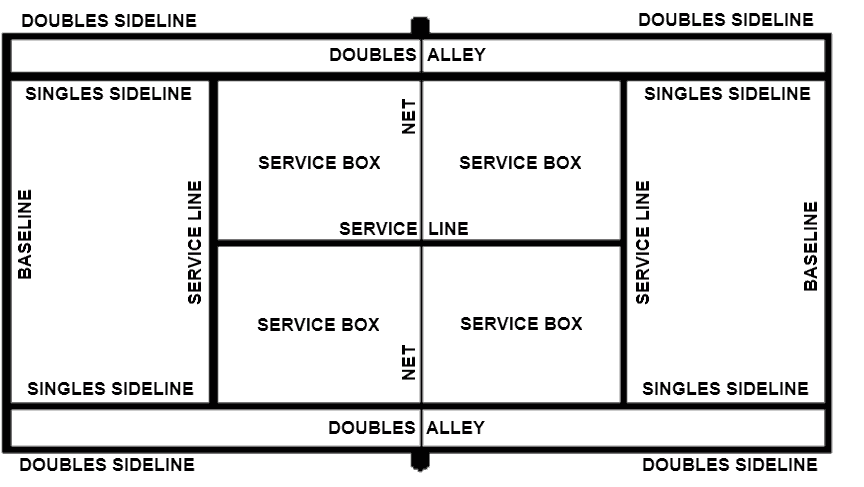
Tennis courts measure 78 feet (23.77 m) in length and 27 feet (8.2 m) in width for singles matches or 36 ft (11 m) in width for doubles matches. A net measuring 3′-0″ (0.91 m) in height at the center and 3′-6″ (1.07 m) in height at the posts, divides the court into two equal halves.
The net posts are located 3 feet (0.91 meters) beyond the doubles line on each side. This allows for added coverage on wide shots. Occasionally players will play the ball very wide and beyond the extents of the net posts.
Tennis can be played as a singles match between two opponents on opposite ends of the court, or as a doubles match with two players on each side. Whether the match is played as a singles match or a doubles match determines which parts of the tennis court are used.
Additional overrun space is needed beyond the boundaries of a court to allow players to reach shots that are very wide or very deep. All together with the overrun area included, the total court area measures 60 feet (18 meters) wide and 120 feet (37 meters) long.
Most tennis courts are outdoor courts. However, indoor tennis courts are not uncommon in areas where rain and snow are prevalent. Indoor tennis courts, like outdoor tennis courts can be any material. The only exception is natural grass.
Indoor courts sometimes use artificial grass in place of natural grass. However, similar to outdoor courts, hard courts are most common indoors. This is primarily due to their easy maintenance relative to other surfaces.
Singles and Doubles Sidelines
In a doubles match, the full width of the court 36 ft (11 m) is used. This includes the doubles alleys on each side. The lines at the furthest extremes (perpendicular to the net) are known as the doubles sidelines. All shots that land on or within the doubles sidelines count as good.
The lines just inside of the doubles sidelines are known as the singles sidelines. These lines demarcate the outer boundary for a singles match, 27 feet (8.2 m) in width. All balls that land wide of the singles line (within the doubles alleys) are considered out in a singles match.
The Baseline
The lines at each end of the length of the court are known as the baseline. Shots must land on or within the baseline for play to continue. If a shot lands beyond the baseline, it is said to be “long”, in other words, out.
The baseline is not only an important boundary for groundstroke shots but also plays a role during serves. When serving, a player must be careful not to step on or beyond the baseline. If this happens, the play results in a foot fault, which is the equivalent of missing the serve.
In the middle of the baseline is a center mark. The center mark divides the baseline into two halves. During service, the player serving the ball is required to serve from the appropriate side of the center mark, depending on the score.
The right side from the vantage point of the server is referred to as the Deuce court, while the right side is the Ad court. When service begins, players always serve first from the Deuce (right) side. On the next point, they switch to the Ad side.
This sequence continues until the Game ends. Players are not allowed to set up past the center mark. They must set up on the side that corresponds with the point being played, that is either on the Deuce Court side or the Ad Court side.
Service Lines and Boxes
The final remaining lines are the service lines, which combined with the net and the singles sidelines form the service boxes. There are two service boxes on each side of the net, four in total in a tennis court.
The service line in the middle of the court (center of the net) is referred to as the center service line. The service line towards the back, which runs parallel to the net, is simply called the service line.
Service boxes measure 21 feet (6.4 m) in depth, measured from the centerline of the net and 13.5 feet (4.1 m) in width measured from the singles boundary line to the center of the court and/or net.
As the name suggests, serves must land within the correct service box or service lines to count as good and for play to continue.
The serve must go over the net cleanly, without hitting or even touching the net and must land in the service box located diagonally from the side the serve is taken from.
The service returner must allow the ball to bounce once before making contact after the serve. If the returner hits the ball before it bounces, the point is automatically awarded to the server.
Lets, Double Faults and Aces
If the serve misses the service box or hits the net, the player gets a second chance to make the serve. If the second serve results in a fault – referred to as a double fault – then the player receiving the ball wins the point.
On the other hand, if the ball touches the net but lands within the service box, this results in a “let”. The server must then repeat the serve. In theory, lets can go on indefinitely until either the ball lands cleanly in the service box or results in a fault.
If the ball touches the net and lands out of the service box, this is considered out. It is the equivalent of missing the serve. For a serve to be a let, the ball must not only touch the net but also land in the correct service box.
A serve that manages to land in and past the receiving player without the player making contact with the ball is referred to as an “ace”. If the service returner touches the ball but is not able to return the shot, this is known as a service winner.
Additional Net Rules
During a match, players are not allowed to touch the net with any part of their bodies or racket. They are also not allowed to cross the net with their racket, even if they themselves do not touch the net.
The only exception to this rule is in instances where the ball is hit with backspin, lands on one side of the court and then bounces back over the net to the opponent’s side.
Shots that are hit along the side of the net and land in are considered good. So long as the shot lands within the boundaries of the court, the ball can be hit around the net post.
Sets, Games, and Matches
Tennis matches are comprised of Sets. Depending on how the match is structured (usually set up in advance), players need to win anywhere from one Set to three Sets (best of five), with best of three Sets being most common.
Sets, in turn, are broken down into Games. A player needs to win at least 6 Games to win the Set by a margin of at least two Games.
If the lead is less than two, then seven Games are required to win the Set. This can be achieved either by reaching seven with a two-Game lead or in the case of a 6-6 tie, winning the Set in a tiebreaker.
Tie-breakers require at least seven points to win, but the margin must be a minimum of two points. If less than two, the tie-breaker continues until one of the players manages to win by a margin of two points.
During a tie-break, players alternate serve every two points, with the exception of the very first serve. On the first serve, the server serves only one point, and then the serve switches to the other player. After that, the serve switches every two points.
The person who serves first is determined based on who received serve the last Game. The player who received serve in the Game prior to the tie-breaker initiates serve during the tie-breaker.
In some tournaments, such as the French Open where tiebreakers are not used, players must win by two Games regardless. This often results in high, double-digit Set scores.
Point Scoring
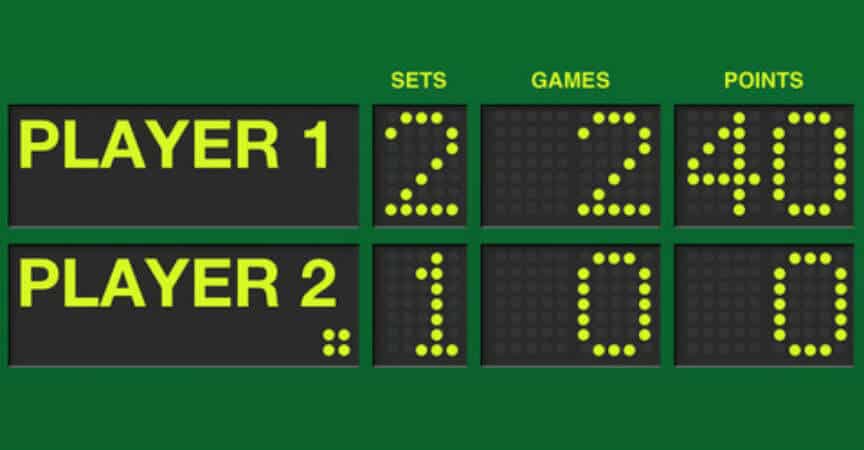
Finally, Games are further broken down into points. Games can be won when reaching four points. Similar to a Set, however, Games must be won by a difference of two points.
Traditional point-scoring works in the following manner. A Game starts out at Love-Love, in other words, 0-0. The first point in a Game is counted as 15. The second point is referred to as 30 and the third point is called 40.
If the player manages to win by a margin of at least two points, they win the Game. The term “All” is used to indicate an even point count. For example, 30-30 could also be referred to as 30-All.
If the score is tied at 40-40, this is referred to as Deuce. Whoever wins the next point is said to have the Advantage (also referred to as Ad for short).
If that same player wins the next point, they win the Game. If not, the score goes back to Deuce. This can continue until one of the players wins by two consecutive points.
In order to distinguish between the serving player having the advantage or the returning player having the advantage, Ad-In or Ad-Out is used. Ad-In means the player serving has the advantage. Ad-Out means the player on the return side has the advantage.
Once a player wins the final point, that’s referred to as “Game”. A new Game then begins with the score at Love-Love. At this point, the player who was receiving serves becomes the server and the player who was serving receives serves.
Break Point, Set Point, and Match Points
When the receiving player is one point away from winning a Game, this is referred to as break point. If the player goes on to win the point, this is referred to as a service break. On the other hand, if the server manages to win the Game during their serve, this is referred to as “holding” serve.
If a player is one point away from winning a Set, the term used is Set point. Depending on the lead, Set points can be repeated if the player who leads does not win the ensuing point. For example, if the lead is 40-Love or 15-Love, it is still Set point on the next serve.
When a player is one point from winning the entire match, it is said to be match point. Once the player wins the final point, it is “Point, Set, Match”. At this point, the match is over and players are expected to shake hands.
Changeovers / Switching Sides
For the sake of fair play, players or teams should switch sides on all odd Game totals. For example, if the score is one Game to none, players would switch. Once the score is 3-0 or 2-1, they would again switch. This gets repeated every time the Game total is an odd number.
This rule is in play because sometimes players will be at a disadvantage in terms of the location of the sun or other site features out of their control. By alternating sides regularly, it reduces the likelihood that one player will have an unfair advantage over the other.
During tie-breakers, changeovers occur every 6 points. Players get two serves each and keep alternating serve until someone wins the tie-breaker. The player who served the first point of the tie-breaker returns serve once the next Set begins.
Doubles Tennis Rules
The only significant difference in the rules between singles and doubles tennis is the boundaries. In doubles tennis, the ball can land within the doubles alley. Doubles tennis is played using the full width of the court.
In doubles, players on each team also alternate between serving or playing up at the net. One player will play out the serve for the full Game and then on their next service sequence their partner will serve for the full Game and they will play up at the net.
Teams can decide to have both players up at the net or both players at the baseline. Alternatively, they can set up with one player at the net and the second player at the baseline. However, during serves, the intended receiver must always receive the ball and is not allowed to switch with their partner.
Tennis Equipment
Besides the tennis court, the game of tennis requires very little in terms of equipment. A tennis racket, a few tennis balls, and tennis shoes are all that is required to play the game.
For comfort, players usually wear shorts with pockets (to hold the tennis balls) and either a t-shirt or polo shirt in more formal competitions. Women also traditionally wear tennis skirts in more formal competition.
In cold weather, sweatpants and a basic sweatshirt or sports jacket can be used to keep warm. In sunny weather, a visor or cap is sometimes used to prevent glare from the sun. Head sweatbands and wrist sweatbands can also be used.
Some additional gear may include vibration dampeners for tennis rackets, used to lessen the vibration of the racket, and tennis overgrips used to improve grip on the handle and absorb sweat. Lead tape is sometimes used to add weight to a racket in specific locations.
Tennis covers or bags are used to store and protect rackets from damage. Some common practice equipment includes ball hoppers or tennis baskets to store and pick up tennis balls. Tennis ball machines can also be used during training to help players practice their shots.
Players who regularly break their strings sometimes string their own rackets. Racket stringing machines can be used under these circumstances, though they require practice and can be fairly expensive.
The Tennis Racket
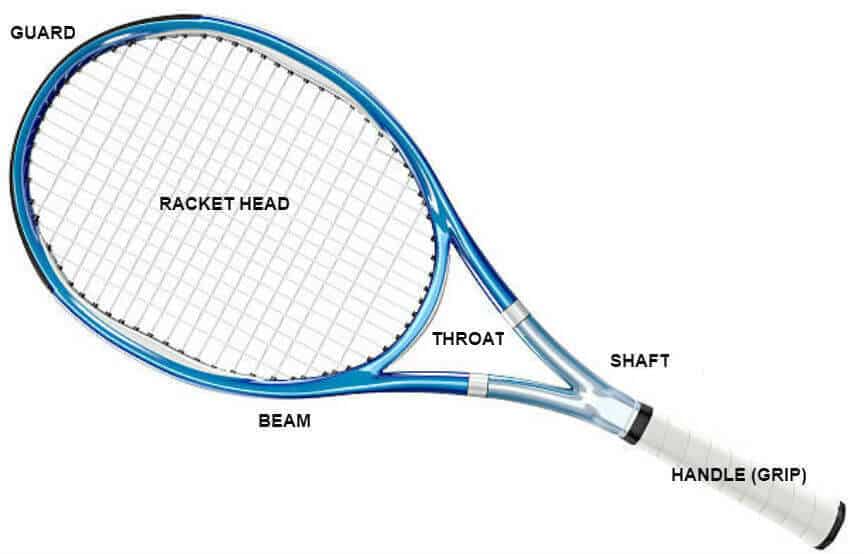
Tennis rackets are composed of a head, a throat, and a handle. The head of the racket contains strings strung through grommets around the inner perimeter of an oval-shaped beam. Often times a guard is located over the beam to protect the head of the racket.
The throat connects the top of the handle to the head of the racket. It is made up of two sections with an opening in the middle. The opening helps keep weight off the racket and is where most of the flex of the racket occurs.
Stiff rackets tend to provide less flex at the throat. This is to provide greater power. The throat and handle combined are referred to as the shaft. The handle is composed of a grip and the butt at the very end of the handle.
While wood was originally the material of choice for tennis rackets, today they are made from a range of materials. Modern rackets are often made from composite materials including graphite, boron/Kevlar, ceramic, or aluminum.
Racket head sizes vary depending on whether they are standard head size, mid-size, mid-plus, or oversize rackets. Standard length rackets are 27 inches in length. However junior rackets can be as short as 23 inches in length and adult rackets up to 29 inches (74 cm) in length.
Racket strings are typically composed of nylon or polyester. Professional or advanced players often opt to use natural gut due to the “feel” of the strings. String tensions can vary from 30 lbs to over 70 lbs, with most players preferring the middle range.
Lower tension ranges increase power, comfort as well as the sweet spot of the racket. On the other hand, tighter strings provide greater control and allow players to generate their own power.
Tennis Balls and Footwear
Tennis balls are made of a hollow, two-piece rubber shell filled with pressurized gas. The rubber shell is covered with felt made from nylon or wool. Tennis balls range between 2 1/2 and 2 5/8 inches in diameter and weigh between 2 and 2 1/16 oz.
While originally white in color, modern tennis balls are primarily manufactured in optic yellow. The only exception to this is junior balls for kids, which can be a mix of red/yellow, orange/yellow, or green/yellow felt.
For practice, and often for use with tennis ball machines, pressureless tennis balls are also manufactured. They tend to last longer than standard pressurized balls, making them ideal for practice. However, they are not allowed to be used during matches.
Tennis shoes differ from other sports shoes in that they provide increased lateral support and a thicker outsole. This allows for side-to-side movement in addition to forward and backward movement. It is important to get a good pair to prevent injuries.
Because tennis involves a good amount of impact on hard surfaces, the thicker outsole is an important requirement of tennis footwear. Not only does it help absorb shock, but it can prevent knee damage in the long run.
With this equipment in place and a comfortable pair of shorts and a tee shirt, you are ready to enjoy the game.
Share this Post
